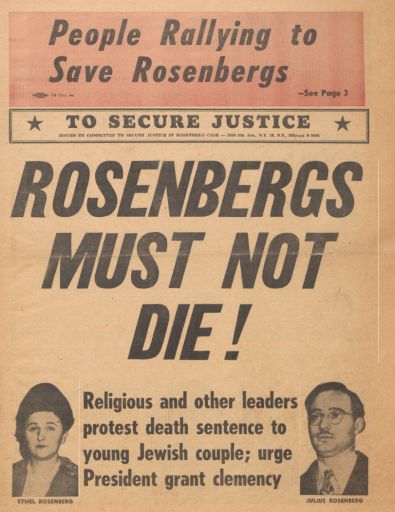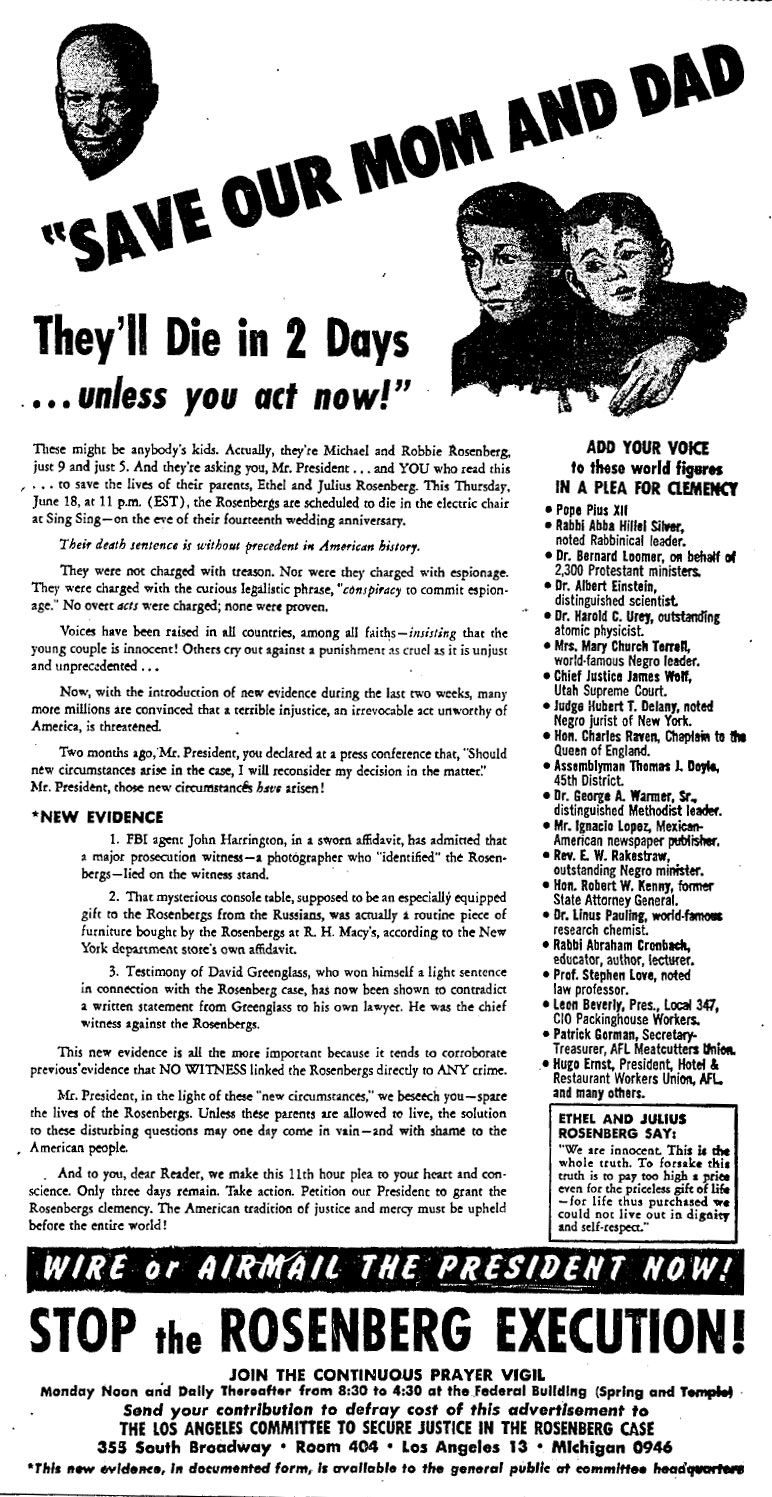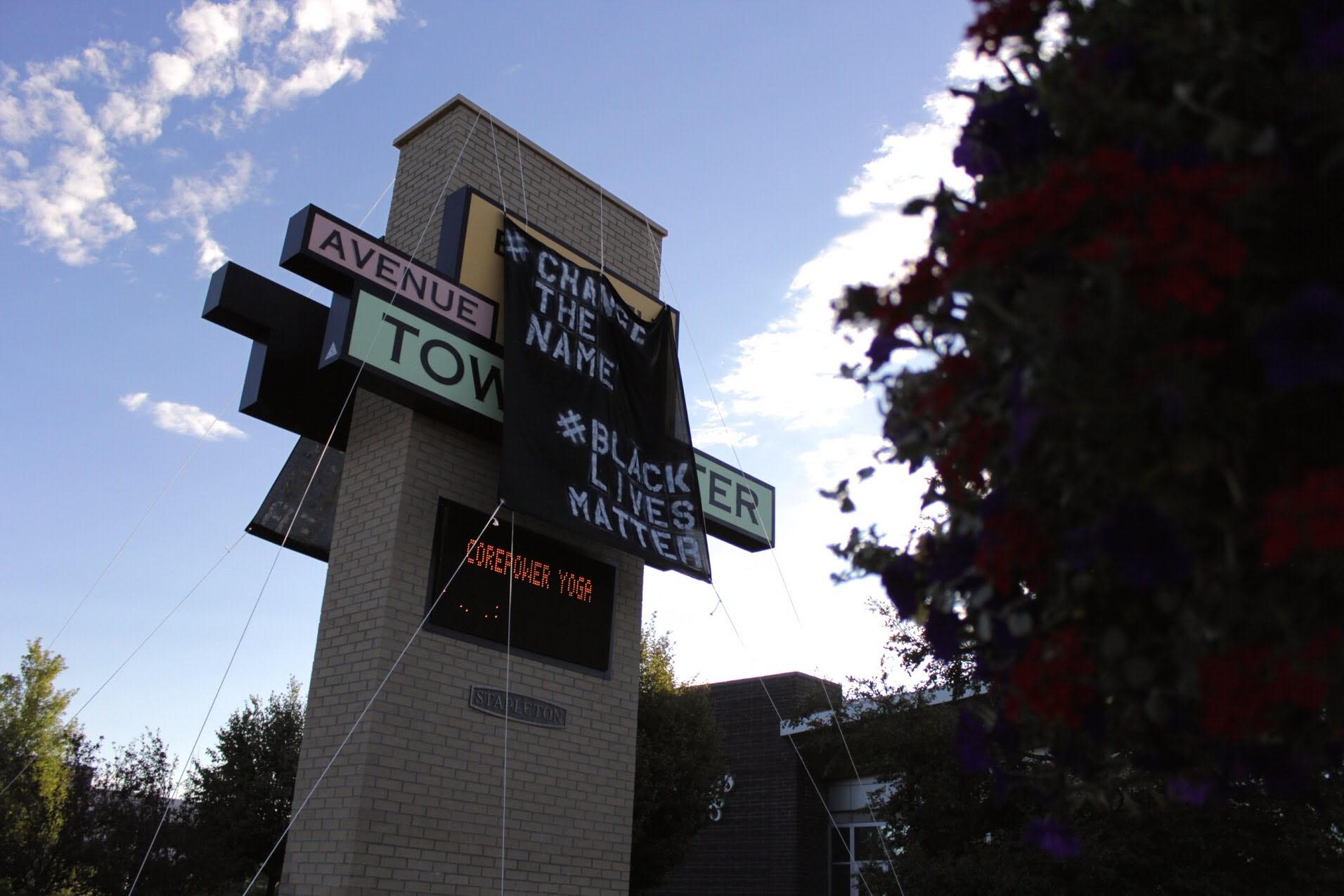This second and likely last installment of Electric Evangelists (see Part 1) looks at longer works by two composers, both choosing to present religious texts simply spoken atop electronic scores. The third and fourth pieces are artifacts of pop culture, coupling SoCal evangelical eccentricity with European élan. The last composition contains no text at all.
Continue reading ““Eat the book”: Electric Evangelists 2″Observing the Sabbath: Killing the Rosenbergs
Note: See also Part 2 and Part 3 of this trilogy.
As early as I can remember I was placed in front of the radio (we had no television). I was exposed to music, advertisements, dramas, and news. At age three I tried to read newspapers. I simply wanted to read about what I’d heard. By the age of five I was reading the “briefs” in the back pages because they were easier for me, but they also could lead me to bigger stories. In particular I remember reading briefs about spies.
I was eight years old in 1950 when Julius and Ethel Rosenberg were arrested on an eventual charge of—not espionage—but rather conspiracy to commit espionage. Their co-conspirator Morton Sobell also was arrested (while in Mexico during which time Julius was arrested).1 Julius had been implicated by Ethel’s brother, David Greenglass, who said at trial that in September 1945 he’d given Julius a nuclear bomb diagram as well as verbal scientific secrets, typed up by Ethel,2 which presumably were transferred to the Soviet Union.
What upset me at first was my concern for the Rosenbergs’ sons. Michael was seven and Robert was three. Ethel had been arrested two weeks before my ninth birthday, at 1:15 on the afternoon of August 11, 1950, after appearing before a grand jury. Arraigned at 4:00, she was denied parole over the weekend to make arrangements for her boys—despite the Jewish Sabbath, which began four hours later, at sunset.3
Ethel’s brother David was the star witness at trial. She and Julius pled the Fifth, refusing to name names, and were convicted by a jury and sentenced to death by the judge, Irving Kaufman, who gave Sobell thirty years and David fifteen.
Spies Optional
I distinctly remember reading that the scientific information the Rosenbergs supposedly obtained was common knowledge and had appeared in textbooks—in Russian! I can’t confirm that now, but at their April 5, 1951 sentence hearing their attorney Emanuel Bloch “read excerpts from a Yale Law Journal article that held that the Soviet Union would have perfected atomic weapons in due course, with or without the help of spies […],” according to historians Ronald Radosh and Joyce Milton.4
The following passage gives a sense of the article’s substance:
While it may be possible to safeguard information against coming into the possession of foreign scientists and thus reduce leaks to countries which may be our enemies in future wars, this cannot be achieved without restricting the free exchange of ideas among our own scientists. Is there, then, a middle way which science and national security can travel together without seriously impeding each other? Many of our leading scientists believe not.5
This was published in 1947.
All-Points Bulletin
A four-page bulletin in support of the Rosenbergs (pictured below), which I hadn’t seen until today, confirms my recollection about the availability of the science. It states that “the government time and time again announced that the ‘secret’ of the A-bomb was no secret,” and that “the plans Greenglass made proved [to be] ‘downright unworkable,’ and ‘made little scientific sense,’ according to Life and Time magazines.”6
I found both those articles today. They’re dated March 26, 1951—just before the Rosenbergs’ conviction on the 29th.

In the Life article, titled “Spy’s Version of the A-Bomb: This is what Sergeant Greenglass had given the Russians in 1945,” the writer states, “At first glance Greenglass’s implosion bomb appears illogical, if not downright unworkable. There seem to be two things wrong with it.”7
Time’s article—“The Greenglass Mechanism”—states that “Greenglass is no scientist (at Brooklyn Polytechnic Institute he flunked eight courses out of eight), and some of his testimony made little scientific sense.”8 (The next month, Life published another article, “The Case of the World’s Greatest Secret,” which contends that “even without Greenglass, Russia had more expert and highly placed sources within the international group of physicists working on the bomb.”9)
Finally, the Rosenbergs bulletin quotes the “Smyth Report”—a document commissioned by the Manhattan Project—which was released publicly on August 12, 1945, just three days after the bombing of Nagasaki:
13.2. A weapon has been developed that is potentially destructive beyond the wildest nightmares of the imagination; a weapon so ideally suited to sudden unannounced attack that a country’s major cities might be destroyed overnight by an ostensibly friendly power. This weapon has been created not by the devilish inspiration of some warped genius but by the arduous labor of thousands of normal men and women working for the safety of their country. Many of the principles that have been used were well known to the international scientific world in 1940.10
The Big One
On July 21, 1952, just before 5 a.m., I was awakened abruptly. “Why are you shaking the bed?” my sister asked. “I’m not,” I replied. “Look outside!” Bright red and blue flashes lit up the sky. “The Russians are bombing us,” I thought to myself. “It’s an earthquake!” our parents yelled. “Run into the hallway.” But I didn’t believe it. I did as I’d been trained to do: duck and cover. It was pitch black because we’d lost electricity. “Where’s Andrea?” asked my father. “You’re standing on me!” I cried.
That was the Tehachapi earthquake, the strongest in California since San Francisco’s in 1906.
An Open Secret
The Rosenbergs became a cause célèbre after their sentencing, with many luminaries calling for clemency. I especially remember Albert Einstein doing so publicly.11 And I thought it was he who said the nuclear information David Greenglass had given Julius was either well known or worthless.12 But it actually was the chemist Harold Urey, Einstein’s Nobel-winning colleague, who said so in a telegram to President Eisenhower:
Greenglass is supposed to have revealed to the Russians the “secret” of the atomic bomb. Though the information supposed to have been transmitted could have been important, a man of Greenglass’ capacity is wholly incapable of transmitting the physics, chemistry and mathematics of the atomic bomb to anyone.13
That telegram was made public on Friday, June 12, 1953—six days before the Rosenbergs were scheduled to be executed. Although I don’t remember seeing an ad like the one below, which appeared in the L.A. Times on the 16th, I do remember reading about how the sons would be orphaned. I begged my mother to send a telegram to Eisenhower asking him to commute their sentences. (I didn’t know how to do that myself and hadn’t yet started babysitting so I had no extra money.) My mother didn’t even answer me. As I walked away, she just laughed, as if it was a ridiculous thing to ask for. It would have cost about a dollar and sixty cents.14
I went to bed. And I wanted to cry but I didn’t cry about things like that in those days. I pulled the covers over my head and felt sick at heart.

This was my coming-of-age moment, at eleven years old. I realized I had to figure out who I was and who I was going to be. I couldn’t just sit on the sidelines and watch people get hurt. I wanted to be better prepared if anything like that happened again.
Observing the Sabbath
The Rosenbergs were killed the next Friday, June 19, 1953. The executions had been stayed a day by the U.S. Supreme Court due to a last-minute appeal by attorney Fyke Farmer. When that appeal failed, the killings were scheduled for 11:00 p.m., but the defense attorneys protested such acts taking place on the Jewish Sabbath. This also worried Judge Kaufman, who moved up the schedule to 8:00, twenty-nine minutes before sunset.
Header image:
Ethel and Julius Rosenberg
by Roger Higgins, 1951,
after their sentencing,
altered by David Hughes
Notes
Acts of Faith: Electric Evangelists 1
Exactly a year ago my discussion with a comrade about music-compelled-by-struggle led to my first original post here, Attica: Coming Together. Last Friday, talking with this same friend caused me to create a list of musics that employ the spoken word—faith-based speech specifically. After jotting down a few titles I came across an extensive list posted for Easter 2013 by one Mr. Fab, a Los Angeles-based deejay and musician. He helpfully includes the name of each orator, which indicates the popularity of two in particular, R. W. Schambach and Gene Scott. My list nearly ended with Praga Khan’s setting of the former in 1991, but Fab provides twenty more years of titles.
My Friday conversation involved Brian Eno and David Byrne’s album My Life In the Bush of Ghosts for which they used the voice of Kathryn “I Believe In Miracles” Kuhlman. While her estate wouldn’t approve licensing, a 1980 UK bootleg of the intended track and others circulated apparently before the official album was released in early 1981.15 Bush of Ghosts was completed in October of 1980 and Eno and Byrne must have scrambled to replace Kuhlman’s vocal: the substitute was an “unidentified exorcist” recorded the previous month in New York. Both these speakers are acts in their own right, with the exorcist commanding (below), healer Kuhlman exploring (at least initially).
On the bootleg (at 2:32) Kuhlman seems to introduce a guest, perhaps on her television show? Her phrasal pauses are electronically elongated in contrast to the musical pulses, turning prose into something this side of poetry.16
Sit down by my side.
Tell me all about that wonderful experience
when you were the possessorof that wonderful gift
whereby you were enabled to see into the spirit world.
This is what he saw…
This is what who saw? Inexplicably (the track does hiccough as if it’d been trimmed)—and murkily in the mix—Kuhlman turns to scripture: the story of Lot, King James Version (itself a poetical prose).
19 And there came two angels to Sodom at even; and Lot sat in the gate of Sodom: and Lot seeing them rose up to meet them; and he bowed himself with his face toward the ground;
2 And he said, Behold now, my lords, turn in, I pray you, into your servant’s house, and tarry all night, and wash your feet, and ye shall rise up early, and go on your ways. And they said, Nay; but we will abide in the street all night.
3 And he pressed upon them greatly; and they turned in unto him, and entered into his house; and he made them a feast, and did bake unleavened bread, and they did eat.
At which point, of course the men of Sodom demand that the angels be flushed out, “that we might know them.”17 To which Lot generously offers his “two daughters which have not known man.” The tale goes even further downhill from there, but Kuhlman—via the X-acto blade of Eno and Byrne?—omits all of this, returning cheerfully to:
But he’d been given that wonderful gift,
which enabled him to see into the spirit world.
These were angels,
angels with Lot,
and angels are just as real in your life and just as real in my life as they were in the life of Lot.
Only he was given a gift whereby he could see into the spirit world and he saw them.
Surely the men of Sodom also were given the gift, else how would they have known there were new men to be known?
And so Eno and Byrne, having been forced to excise Kuhlman, swapped in an exorcist with a demonic laugh, who declares that his exorcisee’s “husband is the head of her house.” Thus the track moved from house to house, from the spirit world to “The Jezebel Spirit,” its title on the album.18
Anthems and Albums
It’s been noted that Eno and Byrne’s vocals appropriations had an antecedent at least ten years earlier with composer Karlheinz Stockhausen’s Hymnen (Anthems, 1966–1967), which sourced national anthem recordings from several countries around the world. And in 1969 Holgar Czukay (German co-founder of Can) with Rolf Dammers created Canaxis 5 by taking a choral a cappella track from a Folkways album, Music of Viet Nam, and giving it a lush setting.19 On Bush of Ghosts Eno and Byrne would do the same with three tracks from the album Music in the World of Islam (a six-LP box set that I let slip through my fingers when I moved back to Colorado). In 1987 Czukay employed the (mostly sung) vocals of Pope John Paul II, below. “We were blessed by the appearance of His Holyness Popestar Wojtyla and His Swinging Nuns during the Easter ceremonies,” Czukay writes in the credits to the Virgin album Rome Remains Rome.
Touching, Funny, and Disturbing
As can be heard, Eno and Byrne’s careful craft is in contrast with Czukay’s nonchalance. The latter approach also is taken by John Adams in a 1973 composition, a recording of which was released by Eno on his Obscure label. Christian Zeal and Activity is the middle movement of Adams’s triptych American Standard. The ensemble performs a deconstructed “Onward Christian Soldiers” but without benefit of bar lines—and with or without a baton. (Eno would use a similar technique for his Three Variations on the Canon in D Major by Johann Pachelbel.20) Adams’s ensemble is accompanied by the “extra material” of a radio talk show recording, which the composer called “touching,” “funny,” and “disturbing.”21 This description actually could apply to all of the repurposed preachings in Mr. Jay’s list.
(Regarding the image used for the following stream of a 1973 performance…22)
At the time of Adams’s success with his opera Nixon In China (1987), but before that work’s release on record in 1988, Nonesuch issued an Adams sampler, demonstrating that the composer already had a portfolio. For that album, in November of ’86 Edo de Waart conducted (or did he?) members of the San Francisco Symphony in the stand-alone Christian Zeal and Activity, this time with the “extra material” of an uncredited 1976 text-sound piece, Sermon.23
Brother Walter Reigns
Perhaps the most famous stand-alone text-sound creation in history is Steve Reich’s It’s Gonna Rain, featuring the voice of “a young black Pentecostal preacher who called himself Brother Walter.” He was recorded in San Francisco’s Union Square; the piece was “composed” there in January of 1965.24
It’s Gonna Rain was incorporated along with other Reich works (including Come Out, which I discuss in my post from a year ago) into Megamix, released by Nonesuch in 1999.
Megamix was crafted by Michael Kandel, aka Tranquility Bass, whose early collaborations under that moniker with Tom Chasteen employ found vocals, such as the Apollo 11 line in 1991’s “They Came In Peace” (a later “Sea of Tranquility” mix echoes Reich), and the South Asian/Latin stylings of ’93’s “Cantamilla.” As far as proselytizing goes, a relatively soft sell is contained within the duo’s 1993 “Mya Yadana (Kin Kin)” (named after the restaurant the two frequented in Bagan, Burma in 1988 and their server Kin Kin).
Power and Poison
Less restrained are the appeals of R. W. Schambach on the first of John Oswald’s famous mashups, “Power” (1975), which aligns the preacher’s calls with Led Zeppelin’s power chords.25
In the 47-page booklet that accompanies Oswald’s Plunderphonics compilation (pictured above), the artist explains:
This is a track which i made while i was working on the « burrows »
—both he and John Adams were taken by the cut-up method (and results) of William S. Burroughs26—
and at the time i somewhat astigmatically decided that the repeating sample idea was not a direction i wanted to go in, and i put it in the closet. Five or six years later i heard that Bush of Ghosts record, which featured electroquoted preachers over rhythm tracks, and the thought crossed my competitive mind that i had already done this, better.
But Oswald explains further:
The basic premise of « power » was a long-standing one for me which dated back at least to my first hearing of Brother J. C. Crawford’s exhortations on the MC5’s Kick out the Jams. Before i knew much about Jerry Lee Lewis’ background, this seemed like the devil’s music. Rock, was eminently suited to be juxtaposed with ranting evangelistic rhetoric, and its brethren in the political arena, exemplified by guys like Adolf Hitler.
J. C. Crawford‘s resemblance to the latter-day Reverend Billy and his Church of Stop Shopping notwithstanding—
—Oswald denies these juxtapositions are ironic.
Rock fans were uncomfortable listening to talk about god and jesus. God and jesus fans were known to be uncomfortable about rock. So, even early on i was striving for my music to be unpopular.27
As I noted up top, preacher R. W. Schambach was a popular subject of electroquotation, to use Oswald’s term. In 1985 the British group :zoviet*france: included its song “Ram” from ’84 on a multi-artist audiocassette compilation, Ritual: Land’s End, issued by Touch. The track actually overlaps the preceding track, “Greater Faith Cathedral broadcast, rec by S/Z,” which is an otherwise unaccompanied exposé by Schambach of the truth behind the 1978 Jonestown Massacre. “Ram” appeared also in 1985 on the group’s own audiocassette album, Popular Soviet Songs and Youth Music, issued by Singing Ringing/Red Rhino, but it omits Schambach’s speech. A 1992 re-release of “Ram” on the group’s own compilation-from-compilations, Collusion (The Grey Area of Mute Records), resurrects the Schambach, perhaps because of the line that had been made famous the year before by Praga Khan.28 But before we get to those tracks, listen to the beginning of “Norsch Baelmaen,” recorded in 1982 and released in 1983 on the Red Rhino EP Norsch, which features another preacher.
And the backwards version…
“Ram” is the first track on Collusion by :zoviet*france:…
…from which Praga Khan borrows key bits, making his own message, calling for an abandonment of the old modus.
And since we’re on the subject: “Jim Jones” by the L.A. band Party Boys, from the 1984 LP No Aggro issued on Independent Records. No electroquotation here but rather the band’s recitation of Jones’s words.
A somewhat sour note to leave you on, but in Part 2 I look at Ralph Swickard’s Sermons of Saint Francis, Pierre Henry’s take on John the Evangelist, Cabaret Voltaire on Gene Scott, and more.
Notes
Sibling Cities in an Invisible Empire
We’re all familiar with the Charlottesville chant from two years ago: Jews Will Not Replace Us.
It’s a perennial paradox. Torch-bearing worshippers of an almighty God, who answers prayers with miracles, and devotion with salvation, at the same time have an inferiority complex as vast as their numbers. In 2014 the Pew Research Center’s Religious Landscape Study reported that if the U.S. had a population of only 100 (adults) there would be two Jews, one Muslim, and 71 Christians. Verily: Jews will not replace Christians. But what might rightly rile these folks are two other Pew stats: 1) only 47 of those 71 nominal Christians are white and 2) as many young people identify as “unaffiliated” as they do “Protestant.” (Earlier I discussed how sex surveys of young people show that about 1 in 5 don’t ID as straight—about the same percentage as the unaffiliated total in the Pew poll.)
KKKpleton
When my wife Andrea Carney and I first moved to our Denver neighborhood in 2005, Andrea found it was named for a mayor who had profited politically from the prototype of what we saw in Charlottesville. We were heartened in 2015 when Black Lives Matter began an effort to change the name.

In July of this year, we and our neighbors (property owners only, no renters) voted whether to retain the neighborhood name Stapleton, which we inherited from the former airport on which our plots are platted. (Our true legacy, of course, is from indigenous people, as explained here.)
Continue reading “Sibling Cities in an Invisible Empire”Vaneigem and Bubblegum
Last week, when I was uninspired whilst reviewing my running list of blog topics, YouTube operated as a sort of Oblique Strategies, the deck of cards initially developed by musician Brian Eno and artist Peter Schmidt independently in the late 1960s and early ’70s. (Eno included four of Schmidt’s prints in his 1977 album Before and After Science.) The cards’ suggestions and comments can act as disinterested—oblique—prods for artists when they encounter roadblocks during the creative process. And so YouTube essentially did the same for me, but not obliquely—rather, evidently, based on my past searches and pointing-and-clicking. “Recommended for you” last week was an obscure track from The Zulu Compilation (1984), an album I happen to have in my collection. Zulu Records was formed by Jayne Casey and Ambrose Reynolds (both of whom also worked in the band Pink Industry, which issued lovely minimalist and melancholic music in the ’80s). The compilation is perhaps most collectible for its inclusion of a pre-Trevor Horn version of “Love Has Got a Gun” by Frankie Goes to Hollywood.
I hadn’t listened to that compilation LP in years and had completely forgotten the track YouTube selected for me: “The Kremlin in Flame [sic]” by S.T.F.O.T.P.A. It sounds like something from the 1976 Art & Language-Red Crayola collaboration, Corrected Slogans (discussed in my post I Found That Essence Rare). After some searching I found the identity of the track’s creators in a 2010 interview by Arthur McDonald of The Royal Family and the Poor fame. Except that I’d never heard of the band. Or, rather, when coming across their LPs, two of which were issued by Factory Records, I’d passed them by.
Continue reading “Vaneigem and Bubblegum”Took Me to Church
Seeing the nave and altar of Notre-Dame de Paris after its recent fire, and thinking of it open to the elements, I had an eery sense of, well, déjà vu. I had been there, literally, with my family on a 2002 trip to France in celebration of my parents’ fiftieth wedding anniversary. But I had been in that ruin, virtually and earlier, twice more.
Continue reading “Took Me to Church”Hanky and bandage, cigarette and perfume
The other day I came across Prashant Bhilare’s recitation of a poem on YouTube. As it streamed, themes like beads were strung on a thread (sūtra, from the Sanskrit)—of imperialism, impermanence, love, possession, exposure. And I was reminded of similar work, such as Marguerite Duras’s The Lover, which I’ve mentioned here before. Her roman-à-clef received the prestigious Prix Goncourt despite its subject: an intergenerational relationship that otherwise would bestir the book burners if not the gendarmes.
Bhilare is more circumspect. Yet, I thought to myself, somehow he shares Duras’s audacity, if not her craft. And I returned to him. The poem is titled “ME.” (Unlike Duras, no subject-or-object equivocation.) Who dares title this thus?
Continue reading “Hanky and bandage, cigarette and perfume”Profile: Wallace de Ortega Maxey, Mattachine Foundation Member, Free Speech Champion
Wallace de Ortega Maxey was a founding member of the Mattachine Foundation, which was the public face of the clandestine Mattachine Society. In that capacity, Maxey is best known as having hosted the Mattachine’s constitutional conventions, in the spring of 1953, at Los Angeles’ First Universalist Church where he was pastor. Later, Maxey became a champion of free speech, to the point of being a defendant in a significant obscenity case.
I composed two versions of the profile of Maxey.
- A relatively brief overview of Maxey’s life focusing on his work with the Mattachine and anti-censorship efforts, posted on The Tangent Group
- A longer profile of Maxey from an ecclesial perspective for The Lesbian, Gay, Bisexual and Transgender Religious Archives Network / Pacific School of Religion








